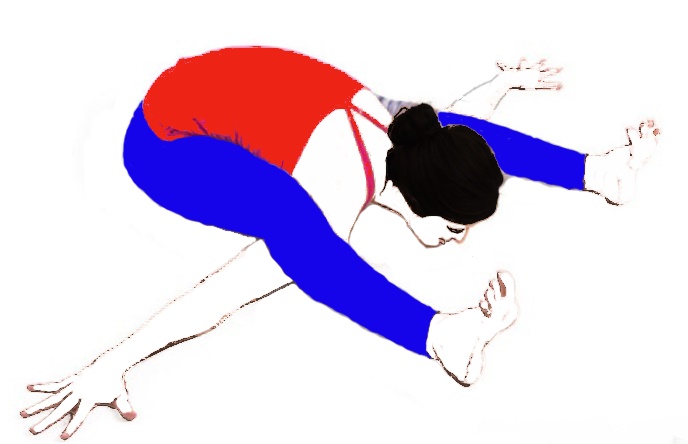 In Sanskrit Kurma implies Turtle or Tortoise, in this Asana your body looks similar to the tortoise in the final step of this pose on the ground. When we watch a tortoise, we see that just the hands and legs distend out from the shell. In the last position, this asana mirrors the tortoise. Kurmasana tones the whole stomach muscles evacuates paunch fat and is used for diabetes. This asana is specified in the Gheranda Samhita, however, the prominent adaptation rehearsed today is somewhat unique in relation to what is said in the established content.
In Sanskrit Kurma implies Turtle or Tortoise, in this Asana your body looks similar to the tortoise in the final step of this pose on the ground. When we watch a tortoise, we see that just the hands and legs distend out from the shell. In the last position, this asana mirrors the tortoise. Kurmasana tones the whole stomach muscles evacuates paunch fat and is used for diabetes. This asana is specified in the Gheranda Samhita, however, the prominent adaptation rehearsed today is somewhat unique in relation to what is said in the established content.
To perform Kurmasana you have to sit with the legs outstretched, feet as widely separated as could be expected under the circumstances. The knees are twisted marginally, keeping the heels in contact with the floor. The body is inclined forward from the hips and the hands slid under the knees. The body inclines forward (twisting at the hips) to permit the hands and arms to slide sideways and in reverse (under the knees) until the elbows lie close to the back of the knees. The heels are pushed forward and legs fixed however much as could be expected. The brow or button is conveyed to touch the floor. The arms are further taken around the back to interlock the hands under the butts.(If you are attempting this asana first time they don’t interlock your hands, after 2 or 3 days you can try it. If you are unable to do that then do this asana without interlocking your arms).
Name: – Kurmasana
Meaning: – Turtle or Tortoise
Preparatory Poses: – Dandasana (Staff Pose), Adho Mukha Svanasana (Downward-Facing Dog)
Sanskrit: – कूर्मासन
Navigator
Steps of Kurmasana (Tortoise Pose)
- First, sit comfortably in Staff Pose (Dandasana) place your hands on the floor close by your hips.
- Now press your thighs into the ground or floor, your feet should flex, and try to lift your chest.
- Keep your legs to the corners of the mat; keep your knee wide as your Take a couple of breaths here.
- Now bend your knees with keeping your feet flexed.
- Place them nearer to your hips. Expand your chest in forward down and keep your arms forward down between your legs.
- Bend your legs significantly all the more, with the goal that you can put your shoulders one by one under your knees. (If this is difficult for you then keep going on with forwarding bend )
- Stretch your arms out to the sides.
- After that try to roll your thighs in the inward direction and keep your inner heels extended, without making pressure in the feet.
- Stretch the front part of your chest and collarbones in forwarding direction and keep them down with the assistance of the weight of your thighs on the shoulders or upper arms.
- Try to push inner heels down and forward to extend and straight your legs, at that moment try to keep your inner thighs in contact with your side ribs.
- Breathe in and keep on extending your arms and mid-section (chest) out to your sides.
- Breathe out to extend your spine more distant forward. Try not to constrain your legs, breathe out and relax to release the pose.
- On the off chance that you feel torment under your knees, take your arms marginally forward. Stay for a couple of breaths, and then gradually leave the posture. Rehash a couple times.
(If you are uncomfortable, then don’t interlock your fingers behind your back, just do this Asana with forwarding bend with shoulders under your thighs. Once you are comfortable in this then try this asana with interlock fingers behind your back)
Variations in Kurmasana
- Upside-Down Tortoise Pose (Uttana Kurmasana).
- Sleeping Tortoise Pose (Supta Kurmasana).
- Half Tortoise Pose (Ardha Kurmasana).
Benefits of Kurmasana (Tortoise Pose)
- It stretches your legs, back, shoulders and chest also.
- It improves the functions of the respiratory and digestive systems.
- It lengthens the back muscles.
- The organs in the midriff (abdomen) are stimulated during this Asana.
- The stance helps you to spread out both your shoulders and your hips.
- The spine is stretched longer during the act of this yoga asana.
- Anxiety buster.
- Beneficial in Asthma, constipation and flatulence.
- Useful in sleeping disorder like Insomnia.
- Beneficial in the problems related to the back or spine.
Note
Don’t try to overstrain your muscles while performing this posture. Breathe in and inhale out the way you would under ordinary circumstances while you are in a definite position of this stance. Avoid this Asana in case of any shoulders, hips or arm injury. (Consult a doctor and yoga expert before starting any Asana or Pranayama; don’t go beyond your capabilities during Asana.)


Thanks for this article on Tortoise Pose. It helps me a lot!
Thanks for appreciating our hard work. Your comment is to work as a catalyst for us. keep doing well & be connected with us.
May God Bless You.